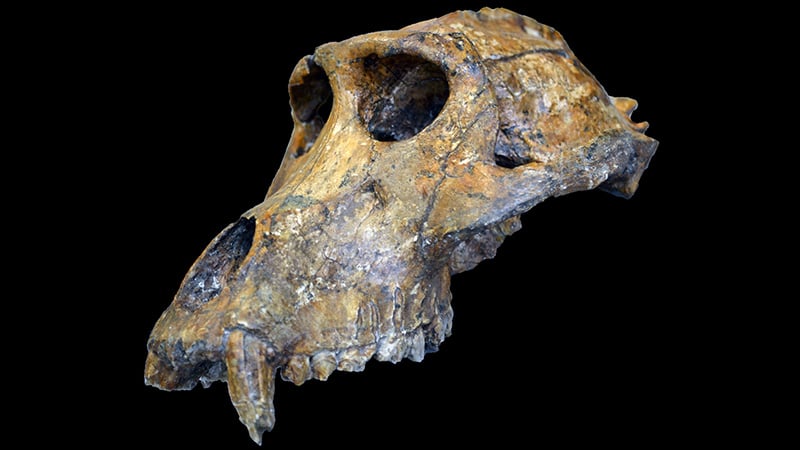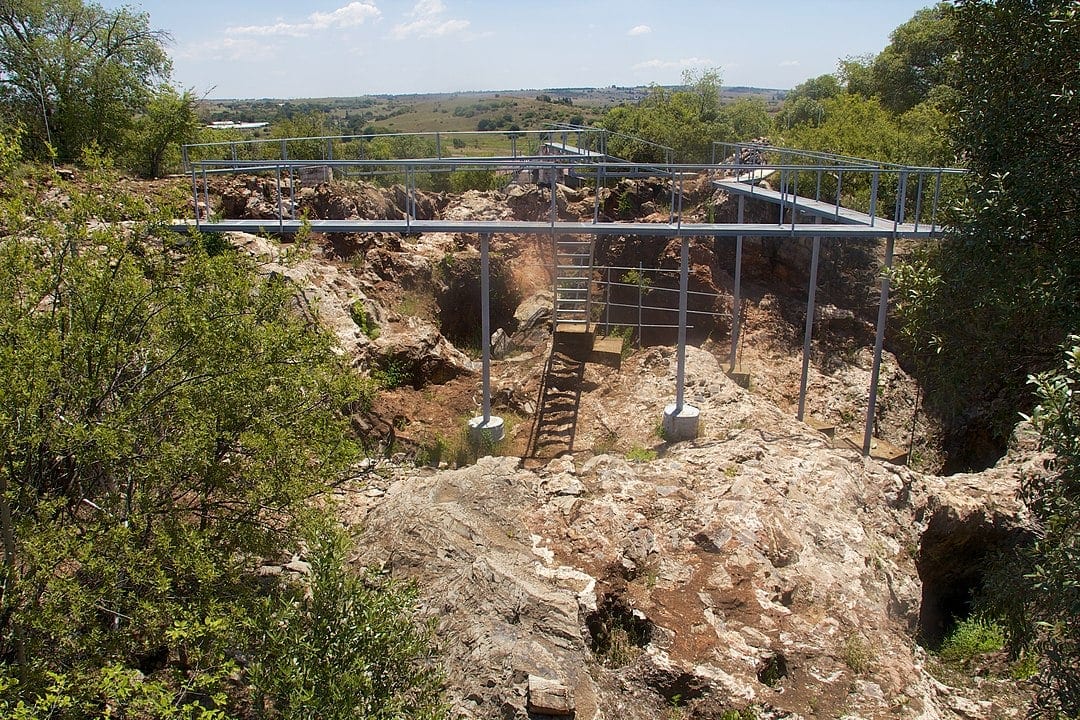
A new study contradicts recent estimates claiming important paleontological sites in South Africa are almost a million years older. Researchers used teeth from an extinct monkey species as a clue to date the ages of hominin fossils throughout South Africa.
by the CUNY Graduate Center (original story here)
Thirty miles northwest of Johannesburg, South Africa, sits a network of limestone caves that contain more fossils of early hominins than anywhere else on Earth.
The Sterkfontein Caves are considered to be among the most important paleontological sites ever to shed light on human evolution, and for good reason: The very first Australopithecus adult fossils were found there in 1936; and it was there, in 1994, that scientists unearthed “Little Foot,” the most complete Australopithecus specimen known today. The caves are part of the Cradle of Humankind UNESCO World Heritage Site.
This week, a team of paleoanthropologists presented revised age estimates for these caves based on biochronology, a dating method that relies on animal fossils to date rocks and related fauna. And they’ve found the caves to be no older than 2.8 million years – almost a million years shy of recent claims.
The scientists say the results could have major implications for the timing of early human evolution.
Monkeys as “fossil clocks”
“The fossil animals never lie,” said Professor Chris Gilbert (GC/Hunter, Anthropology, Biology), who co-led a new study published in the Proceedings of the National Academy of Sciences that uses the teeth and crania of cercopithecoid monkeys, a family of Old World monkeys, to determine the age of these caves and a number of other sites.
“By using the size of the teeth of Theropithecus oswaldi, we were able to reexamine the age of a number of famous early hominin sites in South Africa and determined that there is no evidence that any of the South African cave sites are older than about 2.8 million years,” said Gilbert.
He and co-lead author Stephen Frost traveled the world to study fossil collections from African Plio-Pleistocene sites, once habitats for Theropithecus oswaldi, an extinct species related to gelada baboons.
Historically, monkeys have served as good models for this kind of comparative dating because they’ve been common over the last five million years, said Gilbert, and their bones are found with hominin fossils in both East and South Africa.
Moreover, Theropithecus oswaldi has steadily increased in size through time, so the sizes of its teeth and crania are highly correlated with geological age, said Gilbert. “In essence, these monkeys act as fossil clocks,” he said.
No volcanic rocks
In order to understand the fossil record and human evolution more broadly, we also need to understand time, said Gilbert. “In many parts of the world, we’re very fortunate to have volcanic rocks, which are excellent for dating because they contain natural isotopes that decay at a known rate,” he explained.
As an example, Gilbert pointed to the Rift Valley in East Africa, where precise dates exist for early hominin fossils because of past volcanic activity. Scientists often use potassium-argon and argon-argon dating to determine the age of volcanic sediments at paleontological sites, he said.
But not all sites have volcanic deposits.
“In South Africa, early hominin fossils are found in caves that don’t have any volcanic rocks for dating, so we have to use other methods to figure out how old the fossils are,” Gilbert said. “One of the oldest and simplest ways to estimate age is to look at the fossil animals themselves, and compare them to other fossil animals of known age.”
This dating method is known as faunal dating. The last time monkeys were studied for this type of comparative dating was more than 30 years ago, said Gilbert.
“If you know, for example, that one specific species of antelope, one species of hyena, one species of monkey, and one species of pig are all only known to overlap between two and two and a half million years ago at sites of known geological age, then if you start finding that same antelope, that same hyena … in a cave in South Africa, you can be pretty sure it’s probably somewhere between two and two and a half million years old,” the professor said.
Though not as precise as radiometric dating, faunal dating is highly reliable for estimating a date range, he said.
“The beauty of it is its simplicity,” said Gilbert. “It’s not any sort of fancy new technology. It’s really documenting and paying attention to this very strong evolutionary trend through time. And then using pretty basic statistics to model it, then we can anchor it with any place where you have this monkey Theropithecus oswaldi and say, with a high degree of accuracy, how old those rocks have to be.”

KBS Tuff controversy
In two recent studies, one widely publicized over the summer, the Sterkfontein Caves were estimated to be between 3.4 million and 3.7 million years old, almost a million years older than previously thought. This had implications for fossils such as Little Foot, argued to be the oldest fossil hominin in the cave system.
Armed with evidence taken from the collections of Old World monkey fossils, Gilbert and his colleagues say this finding is flawed. “Despite recent claims, we find no evidence for any site in South Africa being older than 2.8 million years ago,” Gilbert flatly said.
A similar dispute occurred about 40 years ago, when British scientists estimated a volcanic deposit in the East African Rift Valley to be 2.6 million years old. In what became known as the KBS Tuff controversy, that estimate was proven wrong through faunal dating with pig molars and other dating tools. The true age of the volcanic rock was later determined to about 1.9 million years old.
The British scientists used radiometric dating, which was relatively new at the time, said Gilbert. “They were still working out the kinks,” he said. “Basically the same thing is happening here, where you have these newer methods with aluminum-beryllium,” a relatively new kind of radiometric dating, said Gilbert. “They’re getting these dates that just don’t make any sense. The animals are clearly suggesting something is off.”
As with the pigs and the KBS Tuff, he said, “the monkeys are suggesting that these newer dating techniques are likely incorrect and they need further refinement.”
The accurate dating of these sites and the fossils they contain is key to understanding early human evolution, Gilbert said. “That’s why we care so much about how old things are,” he said. “Because understanding human evolution requires that we have some sort of chronology, so we know the approximate order of all these different specimens and can interpret what they mean in the context of who and what the ancestors were, and when important features appear.”
The study was funded by The Leakey Foundation and the Wenner-Gren Foundation.
Original article by the CUNY Graduate Center Office of Communications and Marketing, published October 27, 2022. Learn more about the Graduate Center and its Ph.D. program in Anthropology.
Frost, Stephen R., et al. “Biochronology of South African Hominin-Bearing Sites: A Reassessment Using Cercopithecid Primates.” Proceedings of the National Academy of Sciences, vol. 119, no. 45, Oct. 2022, https://doi.org/10.1073/pnas.2210627119.
Comments 1
GOOD WORK